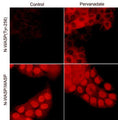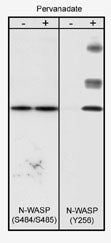Anti-N-WASP (Tyr-256), Phosphospecific Antibody
Our N-WASP (Tyr-256) rabbit polyclonal phosphospecific primary antibody from PhosphoSolutions is produced in-house. It detects human, mouse, and rat N-WASP (Tyr-256) and is antigen affinity purified. It is great for use in WB, ICC.
SKU: WP2601
Ships: 1-2 business days
Product Details
N-WASP (Tyr-256)
Members of the Wiskott-Aldrich sydrome protein (WASP) family regulate the formation of actin-based cell structures in many cell types. These proteins contain C-terminal actin-binding domains that can stimulate actin polymerization. WASP is expressed primarily in hematopoietic cells, while its homolog N-WASP is widely expressed. These proteins have 48% identity in human with higher homology in the functional regions of these proteins. Phosphorylation at serine and tyrosine residues regulates the activity of both proteins. WASP is tyrosine phosphorylated at tyrosine 291 after antigen receptor activation in B-cells and collagen stimulation of platelets. Phosphorylation of the analogous site in N-WASP (Tyr-256) stimulates its activity, reduces nuclear N-WASP, and is required for neurite extension.
Antigen Affinity Purified
Polyclonal
IgG
ICC, WB
Rabbit
WASL
65
Phospho-N-WASP (Tyr-256) synthetic peptide (coupled to BSA) corresponding to amino acid residues around tyrosine 256 of human N-WASP. The human WASP sequence has a two amino acid difference in the same region surrounding tyrosine 291.
Human
Human, Mouse, Rat
Storage at -20°C is recommended, as aliquots may be taken without freeze/thawing due to presence of 50% glycerol. Stable for at least 1 year at -20°C.
Liquid
PBS + 1 mg/ml BSA, 0.05% NaN3 and 50% glycerol
WB: 1:1000
ICC: 1:100
ICC: 1:100
Unconjugated
This antibody was cross-adsorbed to phosphotyrosine then affinity purified using phospho-N-WASP (Tyr-256) peptide (without carrier). The antibody detects a 65 kDa* protein corresponding to the molecular mass of phosphorylated N-WASP on SDS-PAGE immunoblots of A431 cells treated with pervanadate. A similar band is observed in pervanadate treated HeLa and endothelial cells. Weak bands are also observed at higher molecular weights after pervanadate treatment. These bands may be due to low cross-reactivity with phosphotyrosine.
Phosphorylated
Tyr-256
Western blots performed on each lot.
For research use only. Not intended for therapeutic or diagnostic use. Use of all products is subject to our terms and conditions, which can be viewed on our website.
United States
After date of receipt, stable for at least 1 year at -20°C.
Neural Wiskott-Aldrich syndrome protein, WASL, WASP
Blue Ice
Product Specific References for Applications and Species
- Western Blot: Mouse
| Western Blot: Mouse | ||
| PMID | Dilution | Publication |
| 33202906 | not listed | Aladowicz, E, et al. 2020. ShcD Binds DOCK4, Promotes Ameboid Motility and Metastasis Dissemination, Predicting Poor Prognosis in Melanoma. Cancers, 3366. |
| 26490995 | 1:1000 | Elias, BC, et al. 2015. Cdc42 regulates epithelial cell polarity and cytoskeletal function during kidney tubule development. Journal of cell science, 4293-4305. |




